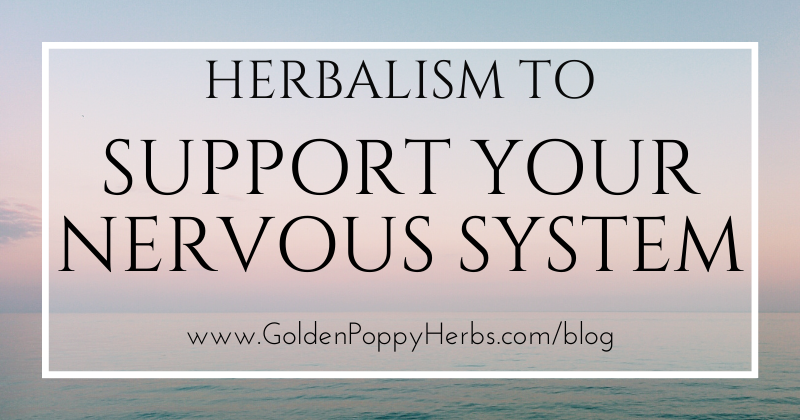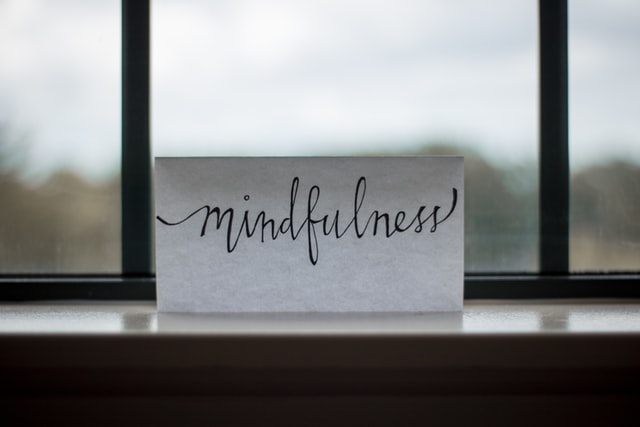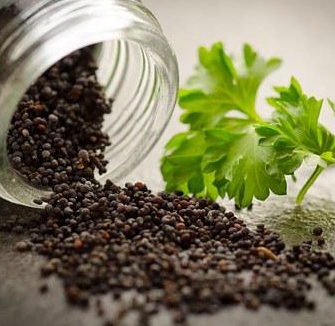
Before we begin this month’s blog post, in which we will call upon herbal allies to help calm our nervous system and support our relief from stress, worry, and anxiety, it felt it might be nice to take a collective breather together. We warmly invite you to join us in a brief grounding exercise, as a way to welcome in this topic of conversation today.
Prior to beginning, if it is helpful for you to put on some soft, calming music, perhaps light a candle or some incense, or maybe even grab a grounding stone such as smokey quartz, we very much welcome you to do so! Make your space sacred and create an environment that ensures your relaxation and comfort.
First, make your body as comfortable as possible. For some, that may mean sitting upright in a chair that supports your spine, with your feet firmly planted on the floor beneath you. For others, you may find a cushion, and choose to sit cross-legged on the floor. And of course, if lying on your back is the most comfortable for you, that is also welcome.
The biggest recommendation we can make is that you choose to sit directly upon the earth itself, outside. Or if that is not possible, perhaps you sit outside on a balcony or porch, to allow yourself to deeply inhale fresh air. Allow the medicine of the earth to assist you in this grounding practice.
Begin to breathe in deeply through your nose. At the top of your inhale, hold your breath for a brief moment, before fully exhaling out of your mouth. We like to count as we breathe, in for a count of 4, hold for 1-2, out for a count of 4, pause for 1-2, and repeat until you feel your mind and body begin to rest.
If it is helpful, and you feel called to do so, you may close your eyes. For others, it may be helpful to have something to focus on, such as a lit candle, a plant ally in your garden, or the smoke that curls upward from lit incense. Your mind may wander a bit, and that is okay. It is not necessary to clear your mind, but when you feel it starting to do so, bring it back to the present moment, and focus on your breath.
As you breathe, visualize a bright, golden light slowly beginning to envelop you from the very top of your crown, moving down your body. As the light passes over you, feel the relaxation and calmness the light brings, within your muscles and spirit. Continue to breathe deeply, inhaling the magic of this light. As it moves down, relax your face, your shoulders, and any unnecessary tension you may be holding in your spine or hips. Relax your stomach, your legs, and down to your toes.
Now visualize a root that begins at the base of your spine. This root is your connection point to the earth and the bridge to your groundedness. Picture this root anchoring you not only to where you are seated or lying but going deeper. Follow the root, feeling yourself becoming more and more still as the root dives deeper into the earth below. Breathe in the feeling of groundedness and the feeling of connection between you and the earth.
Breathe in gratitude, and acknowledge that at any given moment, no matter how brief, we may return to this space. We may return to this space of sacred breath and intimate, grounded connection. Remember that our roots may always return to the earthand that it is here we may find ourselves again.
Breathe in this medicine. Stay here for as long as you need in this groundedness and stillness practice.

Before we continue, we also want to give you permission. Permission to know that you don’t have to just “toughen up” or muster your way through this. We as a collective humanity are having an experience of profound proportions. We are witnessing incredible historical events, are living through periods of deep uncertainty and division, and may be carrying a lot of this in our spirit.
If you feel like you are just getting by, that is okay. If you feel numb, that is okay. If you feel anger, or sadness, that is okay.
Whatever you are feeling, or however you are coping with this (so long as it is not destructive to yourself or others) is okay. We give you permission to know that it is okay to have a reaction in all of this, and to be frank, is normal.
To help guide you on your path towards bringing your system closer to a state of balance, we gently remind you that you can always come back to stillness, and the plants are always, always here as a support system. Most importantly, we remind you that your greatest healer is you and that you have everything you need within you.
The Nervous System
The Nervous System, which is made up of our brain, spinal cord, and nerves, sends and receives “messages,” or electrical impulses, throughout the body by way of neurons. The purpose of our nervous system can be distilled down to three primary functions: 1.) Gather information, 2.) Process information, and 3.) Respond in some way to information.
The Nervous System is broken down into two parts: the Central Nervous System, which is comprised of the Brain and Spinal Cord, and the Peripheral Nervous System. There are also two different aspects of these parts: the voluntary, or Somatic system, and the involuntary, or Autonomic nervous system.
To further understand how a state of dis-ease comes to be, we will further define the somatic and autonomic systems within the Peripheral Nervous System:
- The Somatic (or “Voluntary”) System facilitates chosen movements. For example, when we want to take a step forward, chew our food, wave at a friend across the street, etc., these actions are things we essentially “will” to happen, and the message is sent to our brain to ask the musculoskeletal system to respond accordingly.
- The Autonomic (or “Involuntary”) System is responsible for maintaining and restoring homeostasis, aka balance or a stable equilibrium in the body. It is thought of as “involuntary” because we don’t often think about such things as making our heart beat, or blood pumping through our veins, or asking our stomach to digest food for us. This just happens within the body, thanks to the messages signaled by this system. This system is also further broken down into 2 divisions – the Sympathetic Nervous System and the Parasympathetic Nervous System. The Sympathetic Nervous System regulates the “flight or fight” reaction, whereas the Parasympathetic Nervous System regulates the “feed and breed” state of being, facilitating actions that do not need immediate attention such as resting and digesting.
A state of dis-ease occurs when we are consistently put into the “fight or flight” mode of being. This is also known as being in a sympathetic state. For our ancestors, the stressors that caused this type of stressful state were much different, and often more fleeting. The stress was the result of a predator or the weather conditions. However, in today’s world, we are not often facing such things, and our stressors are instead more frequent. Our world is fast-paced, our economy places a lot of pressure on productivity, and we also face such things as constant and rapid media, including social media, that can put pressures on us we wouldn’t otherwise have.
Not to mention the fact that current events are likely putting profound strain on our nervous systems as we navigate it all. It is very likely that a majority of us are consistently in a sympathetic state, often without even knowing it.

Holistic Practices to Alleviate Nervous System Dis-ease
While there may be a lot going on in our environment, we can take some control of our stress. Incorporating some of the suggested practices can help to bring our being in a sympathetic state back into balance, alleviating feelings of stress, worry, anxiety, or depression.
- Return to Nature. Being in the natural environment is medicine. It is a tonic for our entire being – mind, body, and spirit. When it all feels like a little too much, getting into nature can help. This can be hiking or camping, or it can even be a stroll in the park, or sitting in your garden. Allow the plant allies to hold space for you wherever you are, and enjoy your communion with them.
- Movement. Sometimes it can feel like nervous energy is literally piling up within our bodies. Engaging in movement or exercise can help alleviate and release this energy within us. And we encourage you to make it fun, and something that speaks to your soul! Perhaps dancing your heart out is in the cards for you, or maybe a long, slower-paced trail run is calling to you. Whatever it may be, allow yourself to indulge in the feeling of blood circulating in your veins and air filling your lungs!
- Breath Practice. The fastest way to return to a place of balance and stillness is through our breath. This can be particularly helpful when your state of anxiety might be leading to such things as a panic attack or other similar symptoms. The practice we shared at the beginning of this post is an excellent one. Aromatherapy can also be a great support or even a way to make a ritual out of sacred breath. Incorporate calming essential oils such as lavender, chamomile, or rose. Remember you can always return to the grounding practice we opened this post with.

Herbs to Support the Nervous System
While in a sympathetic state, it might be easy or tempting to reach for such things as caffeine. And while it is true that caffeine will help us remain awake, it can also contribute to feelings of panic or nervousness. Herbs support not only bringing our mind and body nourishment but also can have a profound impact on your nervous system. There are a few different categories of herbs that work on supporting the nervous system, and many of the herbs will fall into more than one of these categories, making them excellent allies to get to know on a personal level.
Nourishing Herbal Tonics.
It is always crucial to ensure that we have a strong foundation from which to work. It is not uncommon in our fast-paced world to lack sleep, skip meals, or lose opportunities to exercise. Nourishing the body is critical to ensure we can return to a state of balance. Nourishing herbs help to support all the systems in the body usually by being nutrient-rich. Some of these include such allies as nettle, oat straw and milky oat tops, and chamomile.
Oat straw, milky oats, and even oatmeal are some of our all-time favorites for this as this plant has a special affinity for the nervous system. Eating oatmeal regularly can help and is probably the easiest way to add this plant into your life. Oat straw tea is also wonderful and has a mild taste that makes it the perfect base for some of the other herbs in this post.
It can also be incredibly helpful to incorporate herbal bitters into your day-to-day routine, as this can help improve digestion, which is often the first part of your body to experience dysregulation during times of stress. This can include consuming more bitter greens in your diet, as well as including herbs that are more commonly taken in tincture forms, such as dandelion, orange peel, or gentian. Check out our herbal bitters to get a glimpse of the possibilities.
Relaxing & Sedating Herbs.
While the name may be a bit misleading, sedative herbs do not actually put us to sleep like chemical/medication sedatives. While some people may feel sleepy with sedatives, their primary function is to calm or ‘sedate’ the nerves, allowing us to relax.
Herbs in this category include chamomile, catnip, passionflower, skullcap, and lavender. Another incredible powerhouse herb to alleviate feelings of panicky anxiety is vervain, however, vervain can have a pretty profound flavor, in both tea and tincture form that not everyone finds palatable, so you may choose to mix it into a juice or other base. Our De-Stress tea and
Adaptogenic Herbs.
The term adaptogen is used to describe the way in which these herbs help us to ‘adapt’ to the changes around us and to the stress our bodies may be experiencing. These herbs are incredibly supportive, especially for the times we are in, and you may have already begun to hear about them as their popularity has gone up exponentially in the past few years. We are experiencing a lot of change in our world – moving, changing (or losing) jobs, health challenges, family and friend challenges, and even the change in the weather as we continue to experience the effects of global warming, can all have an effect on our stress levels.
Herbs in this category include nettle, ashwagandha, schizandra, and licorice root (among others). These herbs tend to work best when used regularly over long periods of time to help support your body.
If you have any questions about the best ways to start using these herbs, or which ones to choose, we highly suggest finding a local practitioner to talk with who can help guide you in finding the ones that will be best for you and your unique situation.

Above all else, may we remind ourselves that we are not alone. An incredible rebellious act against the individualist nature of our culture is to promote and infuse love into our community. Return to your support systems, and nourish them, as this will encourage your own nourishment. Open, honest conversations are a balm for our collective spirit. Don’t be afraid to reach out or to ask for help when it is needed.
And also, get some sleep. You know you need it!
We hope this post is helpful, and we thank you again for supporting Golden Poppy! May these last few weeks of summer infuse sunshine into your very being!
Sources:
Reichley, Tonja. “Lecture: Herbalism for the Nervous System.” Ancestral Herbalism Apprenticeship. 2020. Online.
Browse by category
- Aromatherapy
- Astrology & Magic
- Ayurdeva
- Botany Foraging & Gardening
- Chakras
- Digestion
- Earth Connection
- Energetics
- Flower & Gem Essences
- Folk Traditions
- Herbalism & Holistic Health
- Immune Support
- Materia Medica
- Mushrooms
- Nutrition
- Seasonal Living: Autumn
- Seasonal Living: Moon
- Seasonal Living: Spring
- Seasonal Living: Summer
- Seasonal Living: Winter
- Skin & Body Care

Don’t Miss a Thing!
Enter your email below to be the first to know about sales, new products and tips for taking care of your pieces.

